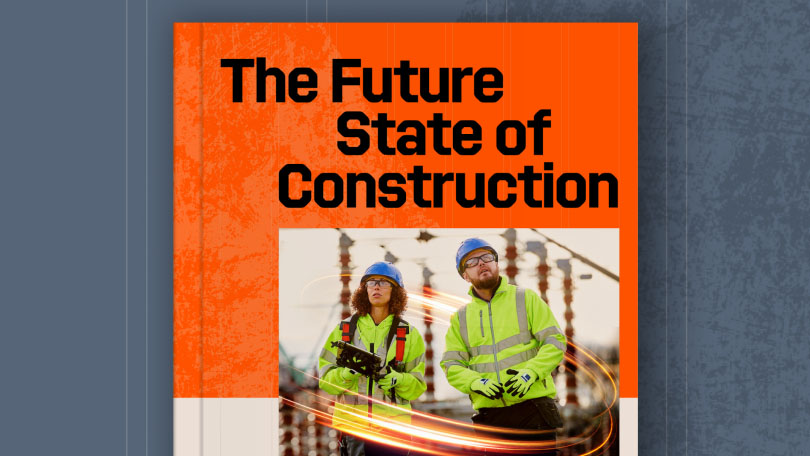— 8 min read
How Construction Companies Can Drive Value from Automation
Last Updated Aug 28, 2025
George Katsibokis
Associate Director
George Katsibokis is an AECO professional (Architectural-Engineering-Construction-Operations) with 25 years of experience in the design and realisation of projects for the built environment. He has worked as a project/development manager and consultant in Europe, Asia, and the UK, leading interdisciplinary, multicultural teams across a wide range of projects of varying complexity and size. George helps project owners work smarter and add value to their projects by offering expert advice and proactively leading project teams from inception to handover. He has held senior positions in the industry in both large corporations and SMEs, as a Project, Development and Operations Director and BIM Lead. Typical projects include high-end developments of outstanding architectural value, B2B services for implementing change in built environment-related businesses (consultants, developers and contractors), as well as large mixed-use residential schemes and infrastructure. His research interests cut across architecture, the digitalisation of the construction industry, the sustainable reuse of buildings and the role heritage plays in the creation of urban places and spaces. George is a graduate of Imperial College and Cambridge (Wolfson College), a Chartered Engineer (CEng), a Member of the Institution of Civil Engineers (UK), the APM (UK), RIBA (UK), and the Technical Chamber of Greece (TEE/TCG).
Last Updated Aug 28, 2025

Most of us use automation in our day-to-day lives, even if we might not realise it. Robot vacuum cleaners, email scheduling tools, contactless payments and navigation apps are all examples of everyday automation that are now commonplace. While automation has become the new norm for our personal lives, it has even greater potential in professional contexts, including in the construction industry.
Construction is an industry that has a struggling reputation in terms of digital transformation. Many thought leaders argue that construction companies aren’t taking advantage of the wealth of digital tools and technologies that we now have at our disposal. However, automation is becoming more and more common in construction, and there is a bright future for its adoption in the industry.
Table of contents
What is automation in construction?
Automation in construction is the process of implementing advanced technologies that streamline processes and reduce the need for manual work. Enabling automation with digital tools allows construction teams to avoid repetitive work, by identifying parts of processes where automatic or digital methods could replace laborious, manual methods.
Automation is quickly transforming the construction industry, and many companies are already automating parts of their projects and processes. This helps them to save time and money.
Implementing Automation in Construction
To benefit from automation, you need to be able to identify the areas where it will have the most impact. It’s important to understand the main processes in a project — and across the organisation — to be able to find opportunities to streamline them. With this understanding, you can map out the individual items within the process. When you’ve identified the individual components of the process, that’s when you’re able to start to create automated workflows.
Collecting data is crucial for a successful automation initiative.
George Katsibokis
Associate Director
AtkinsRéalis
With a good data foundation, you can use information to obtain metrics and results that are meaningful for a project or an organisation. This data can show you, for example, what activities take the most time and would benefit from becoming more efficient. With a combination of a strong understanding of processes and a good supply of data, you can begin the work of choosing which areas make the most sense to automate.
How to Identify Areas for Automation
Automation is all about optimising workflows, which are the systems and steps that you take to carry out a specific process. There are different kinds of workflows. For example, linear workflows, where one task needs to be completed before you can move on to the next task, such as laying a foundation before you can move onto the structural framing. There are also parallel workflows, where tasks are happening at the same time. An example here could be different teams working on different parts of the site at the same time, such as concurrent plumbing work and electrical work.
The type of workflow affects how you could apply automation to it. For linear workflows, you could automate triggers that notify a team when a step has been completed, signalling to them that it’s time for their work to start.
The best way to identify areas for automation is by gaining a deep understanding of the realities of working on a specific site or project. How can you do this? Simply by speaking to the people that do the work and finding out what would make a difference to them.
You need to talk to the people who are part of the process to best be able to work out the various components and convert them into a workflow. Get on site and observe how they’re doing things. Ask them as many questions as you need to.
George Katsibokis
Associate Director
AtkinsRéalis
Going on site — and having site experience yourself — helps you get the full picture of whether a process is efficient or if it holds potential for automation.
How Automation Can Solve Construction Challenges
Automation can be applied to all sorts of problems and bottlenecks in construction. Design changes are one of the biggest challenges we face in the industry. Requests for changes in designs, or changes in materials, force you to reassess the project and whether timelines will be impacted. Doing this assessment, and communicating with the stakeholders about the process, is a time-consuming manual task. Luckily, there are ways to introduce automation to boost efficiency here.
One example is to establish a process to manage these change requests using technology that automatically notifies the right people of a change, asking only for the relevant individuals’ approval. Approvals can be a major blocker in construction, so if you can speed them up by reducing the rounds of approvals, and making them easier with a tool like electronic signing, this is a great help.
Most professionals in my line of work have experienced the frustration of having to reinvent the wheel to create processes for each construction project. Most of the time, the actual procedures are more or less the same. At some point, you realise that a way to standardise and automate processes will help you be more productive.
George Katsibokis
Associate Director
AtkinsRéalis
How to Address Digital Adoption Challenges
There has been significant progress in digital literacy over the last 20 years, as people have become more acquainted with using digital applications — especially with smartphones and tablets. This has made it easier for people who are not tech-savvy computer users to understand the tools. However, there are still challenges to widely adopting automation across an organisation, such as different attitudes to change and different levels of technical literacy.
It’s a guarantee that you’re going to have people with different attitudes to technology, as well as different abilities. In workplaces where there are different generations working together, you may find that you have a mix of digital natives who have no problem working with technology, as well as some workers close to retirement who aren’t as familiar with technological developments (and might not be interested in learning).
Getting people to embrace change is half the battle, but it’s a battle that can be won.
George Katsibokis
Associate Director
AtkinsRéalis
The best way to encourage people who need a little more help with digital automation tools is to bring them along on the journey from the very beginning. Show them the vision that you have and the end result for the organisation. Tell them how it will make their jobs easier. If you explain the benefits that digital tools can bring to the team, instead of just focusing on how to use them, you’re much more likely to get buy in. You need to support people through the change and provide incentives, as well as well-designed processes that don’t create confusion.
Choosing an Automation Tool
There are so many different technology tools that promise to automate processes and unlock efficiencies for companies that it can be overwhelming when trying to choose which ones to invest in. Instead of being distracted by the promises that the tools make, and the add-on features that they advertise, think about the problem you are trying to solve.
Work out how much time a process takes you and how much time you will save when you automate it. Translating this metric into monetary value shows you the real impact a tool can have on your business, and whether it is worth the up-front investment.
You should also consider how well the tool will be adopted by your organisation. Ask these important questions:
+ Is it user friendly and accessible for all levels of digital literacy?
+ Will it help the practitioners do their jobs more efficiently?
+ Does it solve a common, tricky problem?
+ Will it require extensive training, and who will provide it?
+ Is technical support readily available?
Ultimately, the journey of implementing automation in your construction business may have many twists and turns as you try and find the right processes to optimise. But with careful thought and planning, and by choosing the right people to walk you through it, you can make it a journey worth taking.
Future Trend: Smart Contracts
Construction contracts can be contentious documents: issues with contracts are at the heart of many construction disputes. Smart contracts are a future trend and hold a lot of potential for minimising contract issues. A smart contract is a digitised version of a contract stored on blockchain — a secure and unalterable digital ledger — and allows construction companies to use automation to enable contract-related activities.
As IBM writes, “Smart contracts are typically used to automate the execution of an agreement so that all participants can be immediately certain of the outcome, without any intermediary’s involvement or time loss. They can also automate a workflow, triggering the next action when predetermined conditions are met.”
Smart contracts have many benefits. They speed up contract administration and improve accuracy as they are digital and automated, minimising the risk of human error. They also help build trust, as they eliminate the factor of interpretation and give a more objective process.
As we look to the future, I see smart contracts becoming more and more popular and saving lots of time and hassle for construction companies. They are an interesting way to apply automation in construction and hold a lot of potential.
George Katsibokis
Associate Director
AtkinsRéalis
Categories:
Written by
George Katsibokis
Associate Director | AtkinsRéalis
George Katsibokis is an AECO professional (Architectural-Engineering-Construction-Operations) with 25 years of experience in the design and realisation of projects for the built environment. He has worked as a project/development manager and consultant in Europe, Asia, and the UK, leading interdisciplinary, multicultural teams across a wide range of projects of varying complexity and size. George helps project owners work smarter and add value to their projects by offering expert advice and proactively leading project teams from inception to handover. He has held senior positions in the industry in both large corporations and SMEs, as a Project, Development and Operations Director and BIM Lead. Typical projects include high-end developments of outstanding architectural value, B2B services for implementing change in built environment-related businesses (consultants, developers and contractors), as well as large mixed-use residential schemes and infrastructure. His research interests cut across architecture, the digitalisation of the construction industry, the sustainable reuse of buildings and the role heritage plays in the creation of urban places and spaces. George is a graduate of Imperial College and Cambridge (Wolfson College), a Chartered Engineer (CEng), a Member of the Institution of Civil Engineers (UK), the APM (UK), RIBA (UK), and the Technical Chamber of Greece (TEE/TCG).
View profileExplore more helpful resources

Control the Chaos: Standardising Document Workflows in Construction Projects
Document control and implementation play a central role in managing risk, meeting deadlines, and delivering projects to spec. As builds become more complex and teams increasingly disperse, the volume and...

Cost-Plus Construction Contracts in the UK
A construction cost-plus contract – sometimes called a cost-reimbursable or prime cost contract – reimburses all project costs and adds a fee to cover the contractor’s overhead and profit. UK...

Digital Construction Technology for Whole-Life Value
For decades, the construction industry has kept a narrow focus on capital cost — the one-time, upfront costs of a construction project. While in the short term this seems like...

UK Construction Progress Reports: Tools for Smarter Site Management
Construction progress reports track completed work, on site issues, costs, and safety so UK project teams can demonstrate progress, secure payments, and stay on programme. Accurate progress data is essential...
